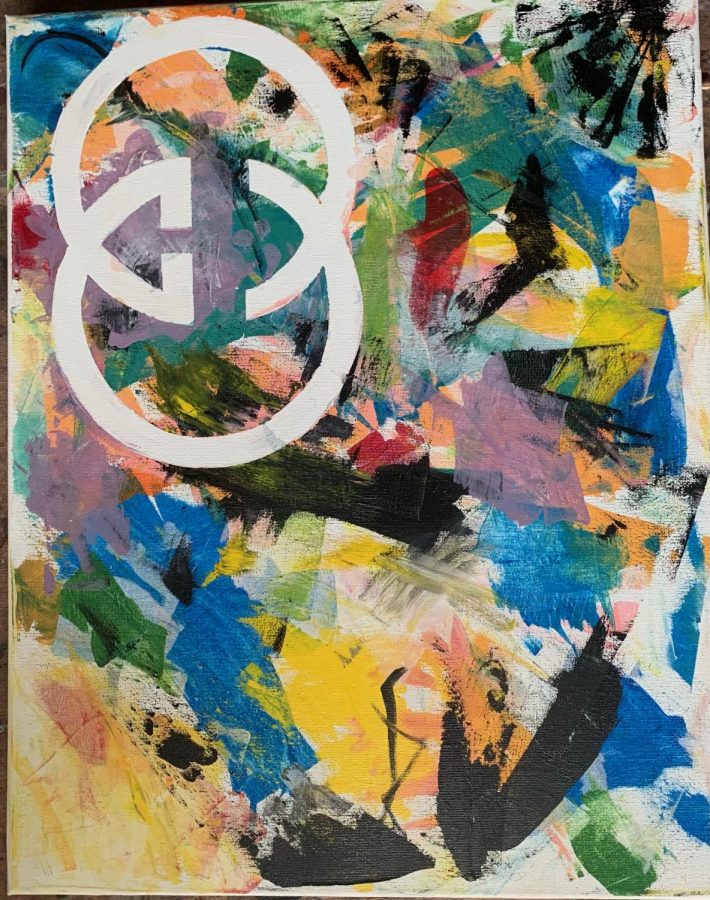Art pathway adjusts to online learning constraints
Students complete all assignments at home, including this piece from an expressionistic logo project.
April 16, 2021
All teachers had to adjust curriculum into the confinement of a computer screen this year. Art teachers had a particularly hard time with this change.
Due to the pandemic, art teachers had to think of new, quick and effective ways of producing, submitting and grading students’ art work virtually. Art teacher John Brandhorst misses what class used to be like before the pandemic.
“I think that there is a lot missed by sitting alone in your home looking at a screen all day long, seeing the same thing every day,” Brandhorst said. “The loss of physical presence of other people is stifling.”
Grady also offers photography classes. In the classroom, students would use cameras to learn the in’s and out’s of film photography. The new standard for the class is for students to take photographs with their phones.
“When we went virtual, we went right into digital [photography] and just used our phones as our cameras,” photography teacher Kimberly Wadsworth said. “Using phones is the same thing but different. Some students are using a camera from home, and others are not. It would be nicer if they had cameras to use, but it still works, and we are still learning a lot.”
Photography students have adjusted to the new class format. Sophomore Riley Browning says the class’s new photography method has been beneficial for her mental state.
“Photography has definitely improved my mental health this year because it allows me to go outside with my friends and take pictures,” Browning said. “I think that being able to go outside and look at what is around you is really great.”
Trying to display the activities and assignments virtually has been difficult for art teachers.
“Being able to demonstrate to kids how to do certain things has been difficult, also because our class is kind of like a cooking show,” Brandhorst said. “I’m not able to gather people around and demonstrate. I can’t show mistakes in the kind of theatrical way that I’m used to. I have my document camera, but it is such a pale impersonation of watching a live demonstration.”
In art, all senses are used to fully recognize a task. The lack of an in-person, sensory experience has made it hard for students to adjust to the new virtual setting.
“It depends on what you are doing because when we do exercises, sure you can tell if you’re doing it right, but the way you hold the pencil can be critical in certain drawing exercises and your teacher can’t come around and adjust it for you,” junior Jamie Roode said. “I tend to procrastinate a bit on projects.”
Art classrooms contain every material projects require. However, that’s not the case when students are home. Teachers have had to adjust their curriculum and teaching plans to adapt to what materials students have at home.
“One of the biggest things we’ve had to simplify this year is the materials that we use,” Brandhorst said. “We had to go back to some of the more simple materials in the first place like pens, pencils and markers because those are things that don’t require cleaning up, making us have to generalize and simplify our approach to some projects.”
Another change is how students turn in work for grading.
“Students turn in a picture of the artwork for grading,” Brandhorst said. “The way I’ve found works is that I will create a slideshow that encapsulates that students work so everyone can see each other’s work, and we can make comments. It’s still not the same as putting work on the wall and being there all together looking at it simultaneously..”
Students are weary of this change because it limits the teacher’s perspective of their art. Beforehand, teachers could get a better sense of student artwork by holding it in their hands.
“It’s definitely a weird way of turning in art because photos don’t show all of the detail and true effort put into the work,” sophomore Lacey Berreth said. “You have to get the lighting just right for the colors to show up correctly to see the true art.”
Roode agrees with Berreth’s sentiment.
“I feel like it is a bit more difficult to turn in a piece because you have to get a picture of your piece of art that accurately represents what it looks like to the human eye,” Roode said. “Obviously, a phone camera doesn’t do it any justice. It’s so much better to get criticism from someone who can see the texture and the actual colors of it.”
Although there have been challenges with the logistics of classes, art remains a creative outlet.
“Art classes are definitely an outlet for people, including myself,” Roode said. “There are classes that are literally art therapy; painting and drawing is meant to be therapeutic and emotionally healing. Art classes are an outlet for anybody who takes them, in some way.”







